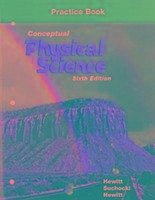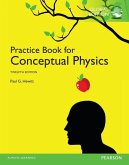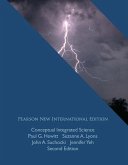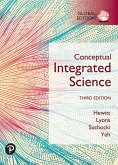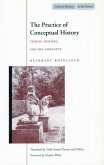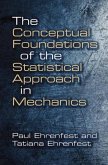- Broschiertes Buch
- Merkliste
- Auf die Merkliste
- Bewerten Bewerten
- Teilen
- Produkt teilen
- Produkterinnerung
- Produkterinnerung
This skill-building workbook helps students build their confidence and understanding of concepts in the textbook by providing additional questions and activities. Answers to all questions are provided at the back of the workbook.
Andere Kunden interessierten sich auch für
![Practice Book for Conceptual Physics, The, Global Edition Practice Book for Conceptual Physics, The, Global Edition]() Paul HewittPractice Book for Conceptual Physics, The, Global Edition39,99 €
Paul HewittPractice Book for Conceptual Physics, The, Global Edition39,99 €![Conceptual Integrated Science Conceptual Integrated Science]() Paul HewittConceptual Integrated Science119,99 €
Paul HewittConceptual Integrated Science119,99 €![The Einsteinian Revolution The Einsteinian Revolution]() Jurgen RennThe Einsteinian Revolution29,99 €
Jurgen RennThe Einsteinian Revolution29,99 €![Conceptual Integrated Science, Global Edition Conceptual Integrated Science, Global Edition]() Paul HewittConceptual Integrated Science, Global Edition93,99 €
Paul HewittConceptual Integrated Science, Global Edition93,99 €![The Practice of Conceptual History The Practice of Conceptual History]() Reinhart KoselleckThe Practice of Conceptual History41,99 €
Reinhart KoselleckThe Practice of Conceptual History41,99 €![Conceptual Foundations of the Statistical Approach in Mechanics Conceptual Foundations of the Statistical Approach in Mechanics]() Paul EhrenfestConceptual Foundations of the Statistical Approach in Mechanics12,99 €
Paul EhrenfestConceptual Foundations of the Statistical Approach in Mechanics12,99 €![International Handbook of Research on Conceptual Change International Handbook of Research on Conceptual Change]() International Handbook of Research on Conceptual Change157,99 €
International Handbook of Research on Conceptual Change157,99 €-
-
-
This skill-building workbook helps students build their confidence and understanding of concepts in the textbook by providing additional questions and activities. Answers to all questions are provided at the back of the workbook.
Hinweis: Dieser Artikel kann nur an eine deutsche Lieferadresse ausgeliefert werden.
Hinweis: Dieser Artikel kann nur an eine deutsche Lieferadresse ausgeliefert werden.
Produktdetails
- Produktdetails
- Verlag: Pearson Education (US)
- 6 ed
- Seitenzahl: 264
- Erscheinungstermin: 13. Januar 2016
- Englisch
- Abmessung: 215mm x 274mm x 15mm
- Gewicht: 624g
- ISBN-13: 9780134091396
- ISBN-10: 0134091396
- Artikelnr.: 44381278
- Herstellerkennzeichnung
- Libri GmbH
- Europaallee 1
- 36244 Bad Hersfeld
- gpsr@libri.de
- Verlag: Pearson Education (US)
- 6 ed
- Seitenzahl: 264
- Erscheinungstermin: 13. Januar 2016
- Englisch
- Abmessung: 215mm x 274mm x 15mm
- Gewicht: 624g
- ISBN-13: 9780134091396
- ISBN-10: 0134091396
- Artikelnr.: 44381278
- Herstellerkennzeichnung
- Libri GmbH
- Europaallee 1
- 36244 Bad Hersfeld
- gpsr@libri.de
Paul G. Hewitt Former silver-medal boxing champion, sign painter, uranium prospector, and soldier, Paul began college at the age of 27, with the help of the GI Bill. He pioneered the conceptual approach to teaching physics at City College of San Francisco. He has taught as a guest teacher at various middle schools and high schools, the University of California at both the Berkeley and Santa Cruz campuses, and the University of Hawaii at both the Manoa and Hilo campuses. He also taught for 20 years at the Exploratorium in San Francisco, which honored him with its Outstanding Educator Award in 2000. John A. Suchocki John is the author of Conceptual Chemistry as well as a co-author (with Paul and Leslie Hewitt) of Conceptual Physical Science Explorations. John obtained his Ph.D in organic chemistry from Virginia Commonwealth University. He taught chemistry at the University of Hawaii at Manoa and then at Leeward Community College. In addition to authoring textbooks, John is currently an adjunct faculty member at St. Michael’s College in Coldchester, Vermont. Leslie A. Hewitt Leslie is also coauthor of Conceptual Physical Science Explorations (with Paul and John). After obtaining her geology degree at San Francisco State University, Leslie’s interest in teaching broadened to include educating elementary and middle school students. She completed additional graduate work in geography and education, receiving her California State Teaching Certification, also from San Francisco State University. In addition to writing, she devotes considerable time and energy to bringing science education to young people in engaging ways.
Prologue: The Nature of Science
PART 1: PHYSICS
1. Patterns of Motion and Equilibrium
2. Newton's Laws of Motion
3. Momentum and Energy
4. Gravity, Projectiles, and Satellites
5. Fluid Mechanics
6. Temperature, Heat, and Thermodynamics
7. Heat Transfer and Change of Phase
8. Static and Current Electricity
9. Magnetism and Electromagnetic Induction
10. Waves and Sound
11. Light
PART 2: CHEMISTRY
12. Atoms and the Periodic Table
13. The Atomic Nucleus and Radioactivity
14. Elements of Chemistry
15. How Atoms Bond and Molecules Attract
16. Mixtures
17. How Chemicals React
18. Two Classes of Chemical Reactions
19. Organic Compounds
PART 3: EARTH SCIENCE
20. Rocks and Minerals
21. Plate Tectonics and Earth’s Interior
22. Shaping Earth’s Surface
23. Geologic Time—Reading the Rock Record
24. The Oceans, Atmosphere, and Climatic Effects
25. Driving Forces of Weather
PART 4: ASTRONOMY
26. The Solar System
27. Stars and Galaxies
28. The Structure of Space and Time
PART 1: PHYSICS
1. Patterns of Motion and Equilibrium
2. Newton's Laws of Motion
3. Momentum and Energy
4. Gravity, Projectiles, and Satellites
5. Fluid Mechanics
6. Temperature, Heat, and Thermodynamics
7. Heat Transfer and Change of Phase
8. Static and Current Electricity
9. Magnetism and Electromagnetic Induction
10. Waves and Sound
11. Light
PART 2: CHEMISTRY
12. Atoms and the Periodic Table
13. The Atomic Nucleus and Radioactivity
14. Elements of Chemistry
15. How Atoms Bond and Molecules Attract
16. Mixtures
17. How Chemicals React
18. Two Classes of Chemical Reactions
19. Organic Compounds
PART 3: EARTH SCIENCE
20. Rocks and Minerals
21. Plate Tectonics and Earth’s Interior
22. Shaping Earth’s Surface
23. Geologic Time—Reading the Rock Record
24. The Oceans, Atmosphere, and Climatic Effects
25. Driving Forces of Weather
PART 4: ASTRONOMY
26. The Solar System
27. Stars and Galaxies
28. The Structure of Space and Time
Prologue: The Nature of Science
PART 1: PHYSICS
1. Patterns of Motion and Equilibrium
2. Newton's Laws of Motion
3. Momentum and Energy
4. Gravity, Projectiles, and Satellites
5. Fluid Mechanics
6. Temperature, Heat, and Thermodynamics
7. Heat Transfer and Change of Phase
8. Static and Current Electricity
9. Magnetism and Electromagnetic Induction
10. Waves and Sound
11. Light
PART 2: CHEMISTRY
12. Atoms and the Periodic Table
13. The Atomic Nucleus and Radioactivity
14. Elements of Chemistry
15. How Atoms Bond and Molecules Attract
16. Mixtures
17. How Chemicals React
18. Two Classes of Chemical Reactions
19. Organic Compounds
PART 3: EARTH SCIENCE
20. Rocks and Minerals
21. Plate Tectonics and Earth’s Interior
22. Shaping Earth’s Surface
23. Geologic Time—Reading the Rock Record
24. The Oceans, Atmosphere, and Climatic Effects
25. Driving Forces of Weather
PART 4: ASTRONOMY
26. The Solar System
27. Stars and Galaxies
28. The Structure of Space and Time
PART 1: PHYSICS
1. Patterns of Motion and Equilibrium
2. Newton's Laws of Motion
3. Momentum and Energy
4. Gravity, Projectiles, and Satellites
5. Fluid Mechanics
6. Temperature, Heat, and Thermodynamics
7. Heat Transfer and Change of Phase
8. Static and Current Electricity
9. Magnetism and Electromagnetic Induction
10. Waves and Sound
11. Light
PART 2: CHEMISTRY
12. Atoms and the Periodic Table
13. The Atomic Nucleus and Radioactivity
14. Elements of Chemistry
15. How Atoms Bond and Molecules Attract
16. Mixtures
17. How Chemicals React
18. Two Classes of Chemical Reactions
19. Organic Compounds
PART 3: EARTH SCIENCE
20. Rocks and Minerals
21. Plate Tectonics and Earth’s Interior
22. Shaping Earth’s Surface
23. Geologic Time—Reading the Rock Record
24. The Oceans, Atmosphere, and Climatic Effects
25. Driving Forces of Weather
PART 4: ASTRONOMY
26. The Solar System
27. Stars and Galaxies
28. The Structure of Space and Time

